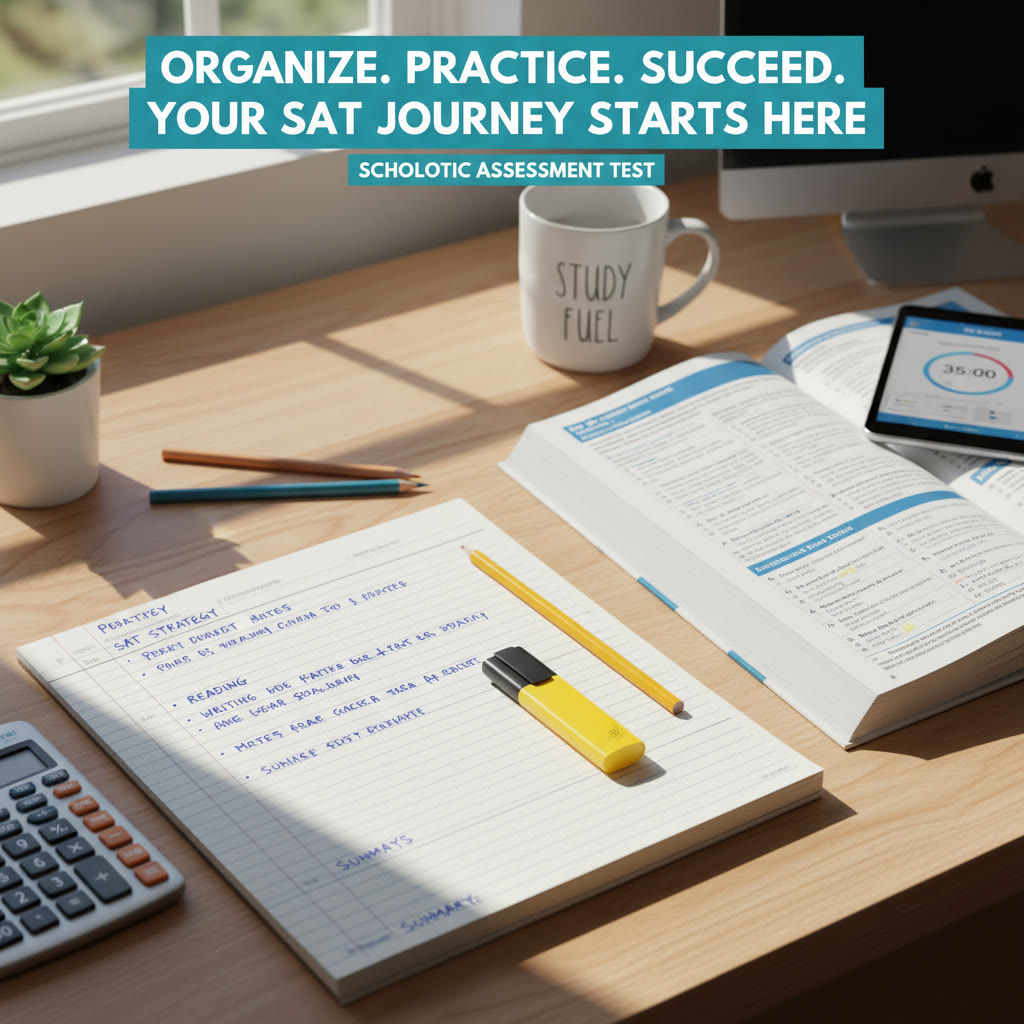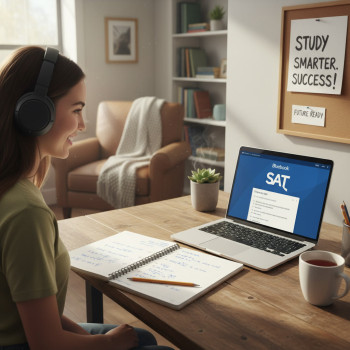Why Note-Taking Is the Secret Weapon of Top SAT Students
Walk into any quiet study spot where a future high scorer is preparing for the SAT and you’ll likely see something others don’t: paper filled with tidy shorthand, margin scribbles connecting ideas, or a digital tablet with color-coded boxes. It doesn’t look glamorous, but those notes hold the scaffolding of a score jump. Strong note-taking is not just about neatness; it’s a learning strategy that transforms passive reading and practice tests into active, retrievable knowledge. This blog unpacks why students who take smart notes consistently outpace their peers, how to take notes for each SAT section, and practical ways to build a study plan around notes — including where Sparkl’s personalized tutoring can naturally amplify the process.
What Note-Taking Actually Does for Your Brain
When you take notes well, three powerful things happen:
- Encoding: Translating a paragraph or a math solution into your own words forces your brain to process information more deeply, which makes it easier to remember.
- Organization: Notes let you structure material so you can find it later — important for spotting patterns in question types, grammar rules, or algebraic techniques.
- Retrieval practice: Well-designed notes become prompts for active recall. When you quiz yourself from your notes, you strengthen memory much more than rereading a passage.
These elements — encoding, organization, and retrieval — are the core of evidence-based learning. In everyday terms: notes stop the knowledge from being a foggy memory and make it something you can reach for under test pressure.
Passive Highlighting vs. Active Note-Taking: A Comparison
Highlighting feels productive because something visible changes on the page. But highlighting alone often creates a cluttered map of words without meaning. Active note-taking, by contrast, converts highlighted bits into working knowledge.
- Highlighting: Marks information but doesn’t require translation or synthesis.
- Active notes: Ask you to summarize, connect, or apply that information — and that’s where learning happens.
Imagine two students reading the same dense passage. Student A highlights phrases. Student B writes a two-line summary, lists the author’s tone, and notes the structure. When a similar passage appears on a practice test, Student B’s brain recognizes patterns faster and with less anxiety.
How Strong Note-Taking Maps to Each SAT Section
Reading: Turn Passages into Portable Logic
Reading on the SAT isn’t asking you to remember every detail; it asks you to see structure, tone, primary purpose, and evidence. Effective notes for Reading capture the skeleton of a passage quickly.
- One-sentence summary: Write a single line that captures the main idea. Force yourself to compress.
- Author’s stance and tone: Angry, nostalgic, curious, skeptical — pick one or two words.
- Paragraph function: For tough passages, label paragraphs (e.g., “setup,” “counterargument,” “example”).
- Evidence flags: Note where a fact or quotation that’s likely to be referenced occurs (e.g., “para 3—study, counterintuitive result”).
Example: For a passage on urban gardening, your note might read: “Main: urban gardens improve food security + community; tone = hopeful/analytic; para2 = evidence study (reduced food deserts).” That tiny scaffold saves minutes when you search for evidence-based questions.
Writing & Language: Build a Mini Grammar Toolkit
Writing & Language tests patterns more than memorization. Notes help you capture grammatical rules and clue words.
- Rule bank: Keep concise rules (subject-verb agreement, comma rules, pronoun clarity) — one line per rule.
- Signal words: Words like “however,” “therefore,” and “because” can shift meaning. Note their functions.
- Common traps: Create a list of errors you consistently miss (verb tense, misplaced modifiers) — aim to reduce them.
Over time, your notes become a quick reference during practice tests. Instead of second-guessing, you verify against a rule you’ve articulated in your own words.
Math: From Steps to Strategies
Math notes should do two things: record reliable processes and catalog quick tricks. Think of them as an engineer’s manual for solving typical SAT problems.
- Template solutions: For every problem type (e.g., quadratic manipulation, systems of equations, functions questions), write the generic steps.
- Key formulas vs. derivations: Don’t just list formulas; jot a simple derivation or the condition when the formula applies.
- Shortcuts and traps: If you often misapply cross-multiplication or forget to check extraneous roots, note the check step.
Example: For function composition, note “f(g(x)) check domain restrictions; evaluate inner g(x) first; quick plug-in with simple numbers to test form.” These bite-sized reminders reduce fumbling under time pressure.
Proven Note-Taking Methods You Can Use for SAT Prep
Cornell Method Adapted for the SAT
The Cornell method divides the page into cues, notes, and summary. Adapt it like this:
- Notes column: Work through problems or passages during practice tests and jot concise steps or paraphrases.
- Cues column: After the section, write quick prompts: “main idea?”, “tone?”, “best substitution?” These become flash questions.
- Summary: End with a 1–2 line summary — the perfect trigger for quick review sessions.
When you return to these pages days later, the cues prompt active recall before you peek at the details.
Two-Column Math/English Breakdown
Create a split layout: left column for “problem/quote,” right column for “approach/answer reasoning.” This forces you to write not just what the answer is, but why the answer works — which is precisely the skill the SAT tests.
Annotation and Margin Tags for Passages
For Reading passages, margin tags speed up navigation. Develop a small symbol system and stick to it:
- ★ = key claim
- → = conclusion
- ! = surprising fact
- ? = counterpoint or ambiguity
Symbols make your notes scannable during timed practice.
How Notes Make Practice Tests Far More Valuable
Practice tests are the raw material; notes are the alchemy that turns practice into improvement. Here’s how:
- Targeted review: Instead of redoing entire sections, you can revisit the specific rules or steps you flagged.
- Error patterns: Notes help you detect recurring mistakes: a misplaced modifier in Writing, weak equation setup in Math, or misreading inference questions.
- Spaced repetition: Convert notes into spaced-review prompts so you re-expose yourself to weak areas at optimal intervals.
Example: Turning a Missed Reading Question into a Learning Nugget
Say you missed a question about author’s tone. In your notes you’d write: “Missed Q 12 — tone = ironic/sardonic; I picked ‘critical’ because I focused on a single example. Fix: always scan for overall attitude across paragraphs, not just one sentence.” That note becomes a quick checkpoint in your next three practice sections.
Data Snapshot: How Note-Taking Habits Relate to SAT Gains
Below is a simple table summarizing typical improvements observed from disciplined note-taking paired with regular practice. These are approximate ranges — actual results depend on baseline level and study time — but the pattern is consistent: organized note-taking accelerates progress.
| Note Skill | Typical Practice Focus | Likely Benefit | Estimated Score Gain (range) |
|---|---|---|---|
| Structured Reading Summaries | Active passage paraphrase + evidence flags | Faster evidence location and fewer inference errors | 20–60 points |
| Rule Bank for Writing | One-line rules + mini-practice | Reduced grammar mistake rate | 30–70 points |
| Math Templates & Checklist | Generic steps per problem type + checks | Less algebraic error, faster setup | 40–90 points |
| Active Review Schedule | Spaced retrieval from notes | Long-term retention, less relearning | 50–120 points |
How to Interpret the Numbers
These ranges are not guarantees; they reflect typical improvements when note-taking is paired with focused practice and review. A student already near a top score may see smaller numeric gains, but their notes will sharpen confidence and consistency — crucial in a high-stakes timed test.
Practical Step-by-Step: How to Build a Note-Based SAT Study Session
Here is a practical 90-minute session that turns time into measurable progress.
- 0–10 min: Quick warm-up: review yesterday’s 2–3 notes flagged for mistakes.
- 10–45 min: Focused practice set (3–5 passages or 10–15 math problems). Don’t rush — use your note structure.
- 45–60 min: Immediate reflection: for each missed question, write a 1–2 line note on the mistake and how to avoid it.
- 60–75 min: Deliberate review: quiz yourself using cues from your Cornell-style notes.
- 75–90 min: Quick summary and set two micro-goals for the next session (e.g., “reduce comma errors” or “master function notation”).
This flow ensures notes move from passive records into active prompts that guide your next study choices.
Common Note-Taking Mistakes — and How to Fix Them
- Too verbose: Long paragraphs in notes are unreadable under time pressure. Fix by summarizing each idea in 5–12 words.
- No review plan: Taking notes and never returning to them wastes effort. Fix by scheduling short review slots tied to spaced repetition.
- No synthesis: Notes that only copy the question or passage miss the point. Fix by always adding one line: “Why this matters for SAT.”
- One-size-fits-all: Using the same note format for math and reading fails. Fix by tailoring the format to the section (templates for math, cues for reading).
How Sparkl’s Personalized Tutoring Can Help You Build Better Notes
Good notes take practice to craft. This is where guided feedback bridges the gap between effort and results. Sparkl’s personalized tutoring offers a natural complement to note-based study in a few ways:
- 1-on-1 guidance: Tutors can review your notes and point out what’s missing, suggest better shorthand, and show how to turn a mistake into a targeted cue.
- Tailored study plans: A tutor identifies the most valuable content to record in notes for your specific weaknesses and creates a schedule that integrates note review and spaced practice.
- Expert tutors: Experienced SAT tutors show how experts summarize passages and solve problems concisely — a skill that’s hard to learn alone.
- AI-driven insights: Sparkl’s platform can flag recurring errors across practice tests, helping you prioritize which notes to create or revisit.
Used wisely, tutoring doesn’t do your work for you — it trains you to make your notes smarter. That multiplier effect is why many students see bigger score gains with a disciplined note routine plus targeted coaching.
What a Tutor Might Do During a Note Review Session
A typical session could include: reviewing your recent practice notes, pointing out weak abstractions, teaching a new shorthand for complex ideas, and creating a two-week “note challenge” where you apply changes and measure the difference. Those small improvements compound quickly.
Creating a Habit: Turning Note-Taking into Second Nature
Consistency matters more than brilliance. Start small: take one focused page of notes each session and commit to revisiting it three times over two weeks. Use your phone or planner to time the reviews. If you’re using digital notes, keep them searchable and taggable (e.g., “verb tense,” “quadratic”). If you like paper, invest in a single notebook devoted to SAT notes so patterns are visible at a glance.
Micro-Habits That Stick
- Always write a one-line summary after finishing a passage or problem set.
- Create a “fix list” of errors and transfer it to the top of your next session’s page.
- Use the same three symbols (★ → ?) and the same shorthand for months — consistency makes scanning faster.
Final Thoughts: Notes as the Bridge Between Practice and Performance
Note-taking is not a relic of high school lectures or an aesthetic choice; it’s a cognitive strategy grounded in how memory and problem-solving work. Students who master note-taking gain clarity under time pressure, see patterns sooner, and turn mistakes into concrete improvements. Whether you’re self-studying or working with a tutor, notes are the artifact that captures learning progress.
Remember: the quality of your notes matters more than the quantity. Aim for notes that make the SAT easier to predict and less stressful to navigate. And if you want guided refinement, Sparkl’s personalized tutoring can provide 1-on-1 guidance, tailored study plans, expert tutors, and AI-driven insights to help make your notes leaner, smarter, and far more effective. The investment you make in learning to take better notes often pays off more than extra hours of unfocused studying.
Quick Action Plan — Your First Week of Note-Based Prep
- Day 1: Choose a note format (Cornell or two-column) and commit to it.
- Day 2–3: Do two practice reading passages; write one-line summaries and margin tags.
- Day 4–5: Create a one-page rule bank for Writing & Language; add three personal common errors.
- Day 6: Build templates for two math problem types you missed most often.
- Day 7: Review everything using cues; write three micro-goals for next week.
Start here, iterate, and watch how small changes turn into steady score improvements. With focused note-taking, disciplined practice, and occasional targeted support — whether from a peer, teacher, or a Sparkl tutor — you’ll find the SAT becoming less of an obstacle and more of a test you can predict and conquer.























No Comments
Leave a comment Cancel